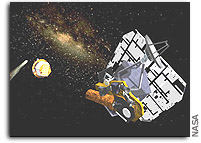Ball Aerospace’s Deep Impact Spacecraft Chosen for NASA’s EPOXI Mission

The successful Deep Impact flyby spacecraft built by Ball Aerospace & Technologies Corp., will be returned to service for two NASA Discovery assignments — the Deep Impact Extended Investigation (DIXI), and the Extrasolar Planet Observations and Characterization (EPOCh), together known as the EPOXI mission.
Deep Impact successfully completed its initial mission on July 4, 2005, when the flyby spacecraft released its impactor spacecraft to create the historic encounter with Comet Tempel 1. The flyby then maneuvered away from the comet’s debris and has since been orbiting around the sun awaiting its next instructions.
“This is an extremely efficient use of the already proven Deep Impact spacecraft that will return additional scientific discoveries for a fraction of the cost of a new mission,” said Cary Ludtke, Ball Aerospace vice president and general manager of the Civil and Operational Space business unit.
The DIXI mission will send the flyby spacecraft to the unexplored Comet Boethin on Dec. 5, 2008. As it passes approximately 300 miles from the comet, the spacecraft’s infrared spectrometer will map the comet’s surface composition, while the telescope observes surface features. While en route to Comet Boethin, the EPOCh mission will use the Deep Impact spacecraft telescope to learn more about previously discovered Jupiter-like planets orbiting nearby stars and search for evidence of Earth-sized planets.
Ball Aerospace will interface with Michael A’Hearn, EPOXI principal investigator and DIXI science team lead; L. Drake Deming, EPOXI’s deputy principal investigator and EPOCh investigation lead; and the Jet Propulsion Laboratory to plan spacecraft trajectory maneuvers and science data collection and downlink to the ground. Events this year include commanding the spacecraft out of hibernation mode, a complete system health checkout, and an Earth flyby for a gravity assist to Comet Boethin.
NASA’ s Discovery missions of opportunity are cost-capped solar system exploration missions with highly focused scientific goals.
Ball Aerospace & Technologies Corp. supports critical missions of important national agencies such as the Department of Defense, NASA, NOAA and other U.S. government and commercial entities. The company develops and manufactures spacecraft, advanced instruments and sensors, components, data exploitation systems and RF solutions for strategic, tactical and scientific applications. Over the past 50 years, Ball Aerospace has been responsible for numerous technological and scientific ‘firsts’ and acts as a technology innovator for the aerospace market.
Ball Corporation (NYSE: BLL – News) is a supplier of high-quality metal and plastic packaging products for beverage, food and household customers, and of aerospace and other technologies and services, primarily for the U.S. government. Ball Corporation and its subsidiaries employ more than 15,500 people worldwide and reported 2006 sales of $6.6 billion.
Forward-Looking Statements
This release contains “forward-looking” statements concerning future events and financial performance. Words such as “expects,” “anticipates,” “estimates” and similar expressions are intended to identify forward-looking statements. Such statements are subject to risks and uncertainties which could cause actual results to differ materially from those expressed or implied. The company undertakes no obligation to publicly update or revise any forward-looking statements, whether as a result of new information, future events or otherwise. Key risks and uncertainties are summarized in filings with the Securities and Exchange Commission, including Exhibit 99.2 in our Form 10-K, which are available at our Web site and at http://www.sec.gov. Factors that might affect our packaging segments include fluctuation in consumer and customer demand and preferences; availability and cost of raw materials, including recent significant increases in resin, steel, aluminum and energy costs, and the ability to pass such increases on to customers; competitive packaging availability, pricing and substitution; changes in climate and weather; crop yields; industry productive capacity and competitive activity; failure to achieve anticipated productivity improvements or production cost reductions, including those associated with our beverage can end project; the German mandatory deposit or other restrictive packaging laws; changes in major customer or supplier contracts or loss of a major customer or supplier; and changes in foreign exchange rates, tax rates and activities of foreign subsidiaries. Factors that might affect our aerospace segment include: funding, authorization, availability and returns of government and commercial contracts; and delays, extensions and technical uncertainties affecting segment contracts. Factors that might affect the company as a whole include those listed plus: accounting changes; successful or unsuccessful acquisitions, joint ventures or divestitures; integration of recently acquired businesses; regulatory action or laws including tax, environmental and workplace safety; governmental investigations; technological developments and innovations; goodwill impairment; antitrust, patent and other litigation; strikes; labor cost changes; rates of return projected and earned on assets of the company’s defined benefit retirement plans; pension changes; reduced cash flow; interest rates affecting our debt; and changes to unaudited results due to statutory audits or other effects.








